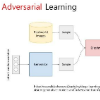Unsupervised domain adaptive object detection aims to adapt detectors from a labelled source domain to an unlabelled target domain. Most existing works take a two-stage strategy that first generates region proposals and then detects objects of interest, where adversarial learning is widely adopted to mitigate the inter-domain discrepancy in both stages. However, adversarial learning may impair the alignment of well-aligned samples as it merely aligns the global distributions across domains. To address this issue, we design an uncertainty-aware domain adaptation network (UaDAN) that introduces conditional adversarial learning to align well-aligned and poorly-aligned samples separately in different manners. Specifically, we design an uncertainty metric that assesses the alignment of each sample and adjusts the strength of adversarial learning for well-aligned and poorly-aligned samples adaptively. In addition, we exploit the uncertainty metric to achieve curriculum learning that first performs easier image-level alignment and then more difficult instance-level alignment progressively. Extensive experiments over four challenging domain adaptive object detection datasets show that UaDAN achieves superior performance as compared with state-of-the-art methods.
翻译:未经监督的域域适应性物体探测旨在将探测器从一个有标签的来源域改成一个无标签的目标域。大多数现有工作采用两个阶段的战略,首先产生区域建议,然后发现感兴趣的对象,在这两个阶段广泛采用对抗性学习来缩小部间差异。然而,对抗性学习可能妨碍对齐样本的调整,因为它仅仅使全球分布在各域之间趋于一致。为了解决这一问题,我们设计了一个有不确定性的域域适应性网络(Uadan),引入有条件的对抗性学习,以不同的方式对齐和不匹配的样品进行对齐。具体地说,我们设计了一个不确定性指标,评估每个样品的对齐,调整对齐和不匹配样本的对抗性学习强度,以适应性调整。此外,我们利用不确定性指标来完成课程学习,首先进行较容易的图像级调整,然后逐步地进行更困难的试级调整。在四个具有挑战性的域适应性对象探测数据集方面的大规模实验表明,Uadan取得优于最先进的方法。




